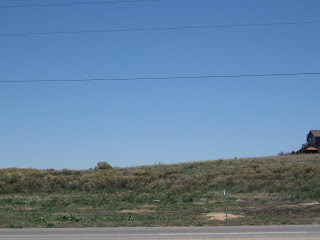I live on Capitol Hill in Denver. Capitol Hill has its own interesting geology, as well as some of the most architecturally interesting buildings in Denver and they were built with readily recognizable rocks. First, I'll talk about Capitol Hill itself, and then some of the great buildings you can find in the area.
Capitol Hill is located east of the South Platte River and north of Cherry Creek, in the South Platte River Basin. The high point of Capitol Hill is in the Denver Botanic Gardens, near 10th Avenue and York Street, at about 5370 feet. The neighborhood is built on
Eolian stabilized dune sand, probably blown out of the banks of the South Platte and Cherry Creek flood plains.
A very good map of the surface geology of Denver can be found at the link below. The crosshairs is right on downtown, and Capitol Hill is to the right, where the color changes to yellow. The yellow is all sand. Just to the left are the South Platte and Cherry Creek. One can see how the dune sand is only on the southeast side of Cherry Creek and the South Platte, and this suggests that it is wind blown sand, as the predominant winds blow from the northwest as they warm and decompress coming down from the neighboring Rocky Mountains. Notice how the stretch of dune sand that Capitol Hill is on trails out to the southeast from just below the confluence the South Platte and Cherry Creek. The grains decrease in size from the northwest, as the wind loses strength in that direction and can't carry the big grains as far.
 http://pubs.usgs.gov/mf/2001/mf-2347/
http://pubs.usgs.gov/mf/2001/mf-2347/The ‘ed’ in the yellow is the stabilized sand dunes. Cherry Creek reservoir is the ‘w’ surrounded by blue.
There’s an older map here:
http://store.usgs.gov/mod/images/i731p.gifI didn’t find any outcrops where this sand might be. However, researchers describe it as being grayish, yellowish quartz sand with some clay and silt. The dunes themselves were generally flat, with some degraded parabolic dunes (arms to the northwest).
In other places in Colorado that are not so heavily developed, one can spot likely sand dunes by the presence of sand sage (Artemisia filifolia).

Sand deposits on Capitol Hill are no more than 6m thick. They sit on top of the Broadway Alluvium, which I’ll talk about in a bit. The sand dunes here are generally leveled before construction begins.
Artemisia filifloia











































